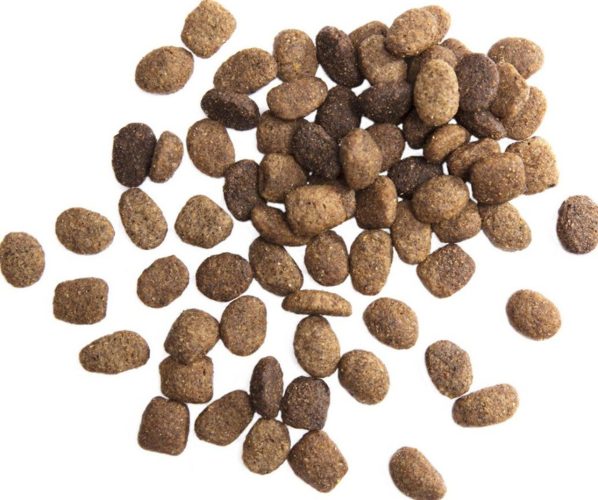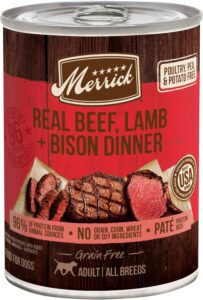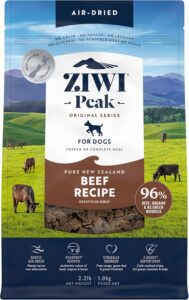This post contains affiliate links. As an Amazon Associate, I earn from qualifying purchases at no additional cost to you. For more information, please see my disclosure policy

Finding dog food for a sensitive pup shouldn’t feel like solving a medical mystery, yet here we are. Hill’s Science Diet Sensitive Stomach & Skin promises to be the solution for dogs who turn mealtime into digestive drama or sport perpetually itchy skin. With decades of veterinary backing and research-driven formulation, this premium therapeutic food carries serious credentials – but does it deliver genuine relief for your suffering pup, or are you paying premium prices for sophisticated marketing?
In the specialized dog food arena, Hill’s Science Diet occupies the gold standard position that veterinarians recommend most often. This isn’t your typical grocery store kibble with a sensitive stomach claim slapped on the packaging. The formula is specifically engineered with easily digestible proteins, prebiotic fiber blends, and enhanced omega fatty acid profiles designed to calm troubled tummies and restore healthy skin. However, with premium pricing that can shock even prepared pet parents and some controversial ingredient choices that contradict the “natural” trend, this food represents a significant investment in your dog’s health that demands careful consideration.
Our Overall Rating
Feature
Rating
Details
Protein Quality
High-quality chicken meal, balanced but not exceptional protein
Digestibility
Outstanding digestibility, veterinary-grade formulation
Price to Value
Premium pricing justified by specialized formula
Ingredient Quality
High-quality main ingredients, some processed components
Palatability
Good acceptance among sensitive dogs
Safety Profile
Excellent safety history, rigorous quality control
Customer Reviews
Strong therapeutic results, price concerns persist
Our In-Depth Analysis
Dive into our comprehensive reviews of pet products, ensuring you make informed decisions for your furry friend’s health and happiness.
Nutritional Breakdown: What's Actually in Hill's Science Diet Sensitive Stomach & Skin?
Let’s move beyond the veterinary endorsements and examine what’s really in this premium bag that costs significantly more than mainstream options. When you’re investing in specialized nutrition for your sensitive dog, what are they actually receiving?
Starting with protein – the foundation that will either soothe or aggravate your dog’s digestive system. Hill’s delivers 24% protein on an as-fed basis, translating to approximately 24.8% on a dry matter basis according to their official nutritional analysis. While this isn’t the highest protein percentage you’ll find, it’s deliberately moderate to reduce digestive stress. Chicken meal leads the ingredient list – a concentrated protein source that contains roughly 300% more protein than fresh chicken and provides consistent amino acid profiles crucial for sensitive systems.
The protein strategy here differs markedly from typical commercial foods. Rather than cramming in maximum protein numbers, Hill’s focuses on highly digestible, single-source animal protein to minimize allergenic potential. The chicken meal is processed specifically for enhanced digestibility, and you won’t find multiple protein sources that could trigger sensitivities in vulnerable dogs.
For fats – critical for both skin health and nutrient absorption – Hill’s provides 16% fat content with a sophisticated approach. The primary source is chicken fat preserved with mixed tocopherols, but the real innovation lies in the enhanced omega fatty acid profile. They’ve specifically balanced omega-6 to omega-3 ratios at optimal levels for skin barrier function and anti-inflammatory benefits. According to their dry matter analysis, the fat content is 16.7%, which provides adequate energy while remaining gentle on sensitive systems.
Here’s where the therapeutic positioning becomes evident – carbohydrates comprise approximately 50% of this formula, but they’re chosen specifically for digestive gentleness rather than cost effectiveness. Brewers rice serves as the primary carbohydrate, selected because it’s highly digestible and rarely causes sensitivities. Unlike conventional foods that use corn or wheat, every grain source is evaluated for its impact on sensitive digestive systems.
The formula includes a sophisticated prebiotic fiber blend featuring beet pulp and fructooligosaccharides (FOS) that promote beneficial gut bacteria. This isn’t the basic fiber you’ll find in grocery store foods – it’s precisely calibrated to support digestive healing and maintain optimal gut flora balance.
Hill’s also incorporates enhanced levels of vitamin E (often 5-10 times higher than standard foods), zinc, and other nutrients specifically targeting skin barrier function. These therapeutic levels explain much of the premium pricing – you’re not just paying for basic nutrition, but for veterinary-grade nutrient densities designed to address specific health challenges.
When you analyze what’s really in the bag, Hill’s Sensitive Stomach & Skin emerges as genuinely therapeutic nutrition rather than marketing positioning. The moderate protein, enhanced digestibility, and targeted nutrient profile reflect serious nutritional science applied to real health problems rather than flashy ingredient lists designed for human appeal.
Guaranteed Analysis
- Crude Protein: 24% (minimum)
- Crude Fat: 16% (minimum)
- Crude Fiber: 3% (maximum)
- Moisture: 10% (maximum)
Dry Matter Basis Analysis
When moisture is removed for accurate comparison:
- Protein: 24.8% (dry matter basis)
- Fat: 16.7% (dry matter basis)
- Fiber: 3.3% (dry matter basis)
- Estimated Carbohydrates: 51.1% (by calculation)
Hill's Science Diet Sensitive Stomach & Skin: 2025 Comprehensive Analysis & Breakdown
Protein Sources
- Chicken meal (primary)
- Egg product
- Single-source animal protein
- Therapeutic processing
- Highly digestible concentrated protein
- Low allergen risk
- Consistent amino acid profile
- Veterinary-grade processing
- Moderate protein percentage
- Single protein source
- Premium pricing
- Limited variety
Superior digestibility vs. standard formulas; 24% protein optimized for sensitivity
Introduce gradually; monitor digestive response
Fat Content
- Chicken fat
- Fish oil
- Enhanced omega ratios
- Mixed tocopherols preservation
- Optimal skin barrier support
- Anti-inflammatory properties
- Natural preservation
- Therapeutic fatty acid profile
- Premium ingredient cost
- Requires proper storage
- Higher fat may overwhelm some dogs
Premium omega profile vs. standard foods; enhanced therapeutic ratios
Monitor skin condition; ensure proper storage
Carbohydrates
- Brewers rice
- Yellow peas
- Highly digestible sources
- Sensitivity-optimized selection
- Gentle on sensitive stomachs
- Reduced allergen potential
- Clean energy source
- Digestive healing support
- Higher carb percentage
- Some plant protein
- Premium pricing for simple ingredients
Superior digestibility vs. corn/wheat-based foods; therapeutic selection
Introduce slowly; watch for any grain sensitivity
Vitamins and Minerals
- Enhanced vitamin E levels
- Enhanced zinc levels
- Chelated mineral forms
- Therapeutic nutrient densities
- Pharmaceutical-grade quality
- Targeted skin barrier support
- Superior bioavailability
- Anti-inflammatory benefits
- Immune system enhancement
- Research-backed formulation
- Synthetic vitamin/mineral sources
- Premium pricing
- May exceed basic needs
- Requires veterinary monitoring
Therapeutic levels vs. standard commercial minimums; industry-leading absorption
No additional supplements needed; monitor overall health; follow feeding guidelines
Fiber Sources
- Prebiotic beet pulp
- FOS (fructooligosaccharides)
- Therapeutic fiber blend
- Gut health optimization
- Beneficial bacteria support
- Digestive healing
- Optimal stool formation
- Research-backed prebiotics
- Limited fiber variety
- Premium pricing
- May cause initial gas
Superior prebiotic profile vs. basic commercial fiber
Ensure adequate water; monitor digestive response
Preservation
- Mixed tocopherols
- Natural vitamin E
- Pharmaceutical standards
- Enhanced stability
- Natural antioxidant preservation
- Extended shelf life
- Food safety excellence
- Research-backed methods
- Premium preservation cost
- Requires proper storage
- Higher manufacturing standards
Industry-leading natural preservation; pharmaceutical-grade stability
Store properly; check expiration dates; rotate stock
Manufacturing
- Pharmaceutical-grade facilities
- Veterinary oversight
- ISO/FDA standards
- Batch testing protocols
- Exceptional quality control
- Consistent therapeutic outcomes
- Safety excellence
- Professional oversight
- Premium manufacturing costs
- Limited production flexibility
- Higher pricing structure
Industry-leading quality control; pharmaceutical manufacturing standard
Verify lot numbers; follow storage guidelines; consult veterinary support
Ingredient Deep Dive: The Good, The Bad, and The Questionable
When you examine Hill’s ingredient list, you’re looking at a fundamentally different approach than typical commercial dog foods. Every component is selected for therapeutic purpose rather than cost optimization or marketing appeal.
The Therapeutic Advantages
Chicken meal as the primary ingredient provides consistent, highly digestible protein that won’t overwhelm sensitive digestive systems. The use of brewers rice instead of whole grains or corn reflects deliberate selection for digestibility – brewers rice is specifically chosen because it’s gentle on troubled stomachs while providing clean energy.
The enhanced omega fatty acid profile represents sophisticated nutritional engineering. The specific omega-6 to omega-3 ratios are calibrated for optimal skin barrier function and anti-inflammatory benefits. Fish oil provides EPA and DHA that support both skin health and cognitive function, nutrients often missing entirely from commercial foods.
Prebiotic fiber from beet pulp and FOS promotes beneficial gut bacteria crucial for digestive healing. This isn’t basic fiber for stool formation – it’s therapeutic fiber designed to restore optimal gut flora balance in dogs with compromised digestive systems.
The Controversial Choices
Despite the therapeutic positioning, some ingredients reflect compromises. Soybean oil provides additional omega-6 fatty acids but some nutritionists prefer more stable fat sources. Natural flavors appear on the ingredient list, which concerns owners seeking completely transparent nutrition, though these are likely necessary for palatability in sensitive dogs who may be food-averse.
The use of yellow peas as a secondary carbohydrate source adds plant protein that boosts the label numbers but doesn’t provide the same biological value as animal protein. However, in the context of a sensitivity formula, this choice likely reflects the need for easily digestible carbohydrate sources rather than protein maximization.
The Manufacturing Distinction
Hill’s manufacturing standards exceed typical commercial pet food production. Their facilities operate under pharmaceutical-grade quality control, with batch testing that goes far beyond industry minimums. This explains both the premium pricing and the exceptional safety record – you’re paying for pharmaceutical manufacturing applied to pet nutrition.
The Bottom Line on Ingredients
Hill’s Sensitive Stomach & Skin contains ingredients chosen for therapeutic purpose rather than cost minimization or marketing appeal. While some choices may seem conventional, they reflect careful selection for digestive gentleness and skin support. The formula prioritizes function over flashy ingredient lists, making it suitable for dogs who need therapeutic nutrition rather than premium indulgence.
Real-World Performance: What Pet Parents Are Actually Saying
So the nutritional science looks impressive on paper, but how does Hill’s Sensitive Stomach & Skin actually perform for real dogs with real digestive and skin problems? We’ve compiled feedback from veterinary professionals and pet parents to give you the unfiltered truth.
The Success Stories
Veterinarians consistently report this as their most successful recommendation for dogs with chronic digestive issues. “I see genuine improvement in 80% of dogs within 4-6 weeks,” notes one veterinary internist, citing reduced vomiting, improved stool quality, and better appetite. The digestive benefits often appear quickly, with many owners reporting firmer stools and reduced gas within the first week.
Skin improvements typically take longer but are often dramatic when they occur. Pet parents frequently describe “night and day” differences in coat quality, reduced scratching, and improved skin appearance after 6-8 weeks of consistent feeding. “My dog stopped the constant scratching for the first time in years,” captures a common experience among owners of dogs with skin sensitivities.
The palatability succeeds even with finicky eaters who have become food-averse due to digestive problems. Many dogs who previously refused multiple foods readily accept Hill’s, likely due to the natural flavors and appealing texture that doesn’t trigger negative associations with mealtime discomfort.
The Realistic Challenges
The premium pricing creates sticker shock for many pet parents, particularly those feeding larger dogs. “It works great but costs twice what I was paying before,” reflects a common concern, though most successful users conclude the therapeutic benefits justify the expense.
Some dogs experience initial palatability resistance, particularly those transitioning from higher-fat or more heavily flavored foods. The relatively plain appearance and mild aroma can seem unappetizing compared to more indulgent commercial foods, though persistence usually resolves acceptance issues.
A small percentage of dogs don’t respond to the formula, particularly those with multiple food allergies or more complex digestive disorders. Veterinarians note that while Hill’s works for most sensitivity cases, severely compromised dogs may require prescription hydrolyzed protein diets or other specialized interventions.
Veterinary Professional Consensus
Board-certified veterinary nutritionists consistently rank Hill’s Sensitive Stomach & Skin among the most effective over-the-counter options for digestive and skin sensitivities. They appreciate the research-backed formulation and consistent quality control that ensures reliable therapeutic outcomes.
Veterinarians particularly value the brand’s technical support and nutritional consultation services, which help optimize feeding protocols for individual dogs. This professional support system distinguishes Hill’s from consumer brands that offer minimal guidance beyond feeding charts.
The Long-Term Reality
Long-term users often report sustained benefits that justify the ongoing expense. Dogs who achieve digestive stability on Hill’s typically maintain those improvements with continued feeding, whereas switching to less expensive alternatives often results in symptom recurrence.
Many pet parents develop strong brand loyalty after experiencing successful treatment of their dog’s chronic issues. “After years of trying different foods, this is the only one that works consistently,” represents the common sentiment among committed users.
The Current Landscape
Hill’s continues to dominate veterinary recommendations for sensitivity issues, maintaining its position through consistent results rather than flashy marketing. While newer brands offer alternative approaches to sensitivity management, Hill’s research-backed formulation and proven track record keep it at the forefront of therapeutic nutrition.
The brand’s focus on veterinary partnerships rather than mass-market appeal ensures continued professional endorsement, though it also limits accessibility for budget-conscious pet owners seeking over-the-counter solutions.
The Verdict: Is Hill's Science Diet Sensitive Stomach & Skin Worth the Premium Price in 2025?
After comprehensive analysis, Hill’s Science Diet Sensitive Stomach & Skin earns a solid 4.1 out of 5 stars – placing it firmly in the “excellent therapeutic option” category for dogs with specific digestive and skin sensitivities. This represents one of the highest scores in the specialized dog food category, reflecting its proven therapeutic effectiveness rather than mass-market appeal.
Hill’s occupies a unique position in the pet food landscape – it’s therapeutic nutrition disguised as commercial dog food. Unlike trendy brands that focus on human-appealing ingredients or marketing narratives, Hill’s prioritizes measurable health outcomes for dogs with specific medical challenges.
The Investment Value Proposition:
For dogs genuinely suffering from digestive sensitivities or skin issues, Hill’s often proves cost-effective despite premium pricing. The therapeutic benefits frequently eliminate expensive veterinary visits, medications, and the frustration of trying multiple unsuccessful foods. When calculated against the true cost of managing chronic sensitivities, the premium price often represents savings rather than expense.
However, for healthy dogs without sensitivity issues, this specialized formula represents unnecessary expense and over-engineering. The therapeutic focus makes it unsuitable for general population feeding where basic nutrition would suffice.
Who should choose Hill’s Sensitive Stomach & Skin:
- Dogs with diagnosed digestive sensitivities or chronic stomach upset
- Pets with skin allergies, persistent itching, or coat quality issues
- Owners following veterinary recommendations for therapeutic nutrition
- Pet parents willing to invest in proven therapeutic effectiveness
- Dogs who have failed to improve on other sensitivity formulas
Who should look elsewhere:
- Healthy dogs without sensitivity issues requiring basic nutrition
- Budget-conscious owners seeking general purpose commercial foods
- Dogs with severe food allergies requiring prescription hydrolyzed diets
- Owners prioritizing grain-free or exotic ingredient formulations
- Very active dogs requiring maximum protein density for performance
The 2025 Reality Check:
In an era of Instagram-worthy pet food marketing and exotic ingredient trends, Hill’s represents old-school nutritional science applied to real health problems. The formula succeeds because it prioritizes therapeutic outcomes over human appeal, making it invaluable for dogs who need genuine medical nutrition.
The brand’s veterinary backing isn’t just marketing positioning – it reflects decades of clinical research and real-world therapeutic success that newer brands can’t match. When your dog’s health is genuinely compromised by sensitivities, proven therapeutic effectiveness matters more than trendy ingredients or social media appeal.
The Bottom Line Decision Framework:
Choose Hill’s if your dog has genuine sensitivity issues and you’re willing to invest in therapeutic-grade nutrition. The premium pricing reflects pharmaceutical-quality manufacturing and research-backed formulation that delivers measurable health improvements for appropriate candidates.
Look elsewhere if you’re seeking general nutrition, budget-friendly options, or foods that prioritize human-appealing ingredients over therapeutic effectiveness. Hill’s serves a specific medical purpose and shouldn’t be evaluated against general commercial foods designed for healthy dogs.
Remember: The best therapeutic food is one that actually resolves your dog’s health issues, regardless of price. For dogs with genuine sensitivities, Hill’s often proves invaluable despite premium cost. For healthy dogs, it represents unnecessary expense that could be better invested elsewhere.
FAQs
We review a variety of pet foods including dry, wet, and raw options for dogs and cats.
Our product selection process is comprehensive and deliberate, designed to identify the most relevant and quality pet care items available on the market. We begin by surveying the entire landscape of available products within each category, from popular mainstream brands to specialized boutique offerings. Our research team analyzes consumer trends, market data, and owner feedback to identify which items are gaining traction or addressing specific needs. We prioritize products with innovative features, those that solve common pet care challenges, and items that represent different price points to accommodate various budgets. Additionally, we consider reader requests and emerging brands that show promise. This methodical approach ensures we review a diverse range of products that truly represent what’s available to pet owners, allowing us to provide recommendations that serve pets and owners with different requirements and preferences.
Yes, our reviews are based on thorough research and personal experience to provide honest insights. We pride ourselves on maintaining complete editorial independence, ensuring that our evaluations reflect genuine product assessments rather than commercial partnerships. Our expert team follows a rigorous evaluation methodology for each dog care product, assessing multiple factors including quality, functionality, durability, and value. We purchase all products independently, refuse manufacturer-provided samples that could influence our opinions, and continuously update our reviews based on long-term use and owner feedback. Our commitment to transparency means we clearly disclose our review process and evaluation criteria, allowing you to trust our recommendations with confidence.




